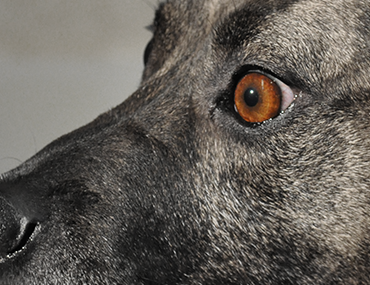
For more from Dr. Ernie Ward, find him on Facebook or at www.drernieward.com.
I can’t tell you how many times I’ve heard that dogs only see in black in white. I’ve always explained dogs can see many shades of colors, especially blues and yellows. I can’t tell you how many times I’ve then been told that, yeah, dogs see gray.
Recent research from Russian scientists verified earlier work on what colors dogs actually see. Before we learn their findings, it’s important we review a little about how the eye detects color in the first place.
Humans have specialized light receptors in the back of the eye called cones. Cones allow us to differentiate red from blue, green from yellow, and the entire visual spectrum as we know it. Humans have three types of cones, allowing us to see all the colors of the rainbow while dogs are limited to two cones, thus reducing the number of pigments they perceive.
Humans see the rainbow as violet, blue, blue-green, green, yellow, orange and red. The long-held belief has been that our canine companions see it as dark blue, light blue, gray, light yellow, darker yellow (almost brown), and very dark gray. In short, dogs see the colors of the world as basically yellow, blue and gray. This was well documented in brilliantly-conducted research by the clinical ophthalmologist Dr. Jay Neitz at the University of California, Santa Barbara in 1989. End of story. Or was it?
Not all scientists agreed with Neitz. Many believed dogs were actually detecting changes in brightness, not discriminating colors. Others went as far to say that dogs didn’t rely on color during their day-to-day activities. So much for Dog TV in HD. A team of scientists from the Laboratory of Sensory Processing, Institute for Information Transmission Problems, Russian Academy of Sciences (I’m not making that up) designed a clever experiment to settle the debate of color versus brightness once and for all. Their results weren’t all that surprising.
Turns out dogs can most certainly see in colors, at least blues and yellows as reported by Neitz. In the Russian study, they trained dogs to receive a food reward when shown four different colored pieces of paper, dark and light yellow, dark and light blue. They then introduced dark and light shades of other colors the dogs hadn’t been taught. A significant majority of the dogs chose the dark and light colors they’d been shown, not the dark and light new colors. This proves dogs can use color to differentiate rather than brightness. Clever. I guess it’s okay to subscribe to Dog TV in HD after all.
The take-home message for pet parents is that dogs see blues and yellows much as we do. I’m always perplexed when I see bright, shiny red balls and toys made for dogs. They must appear quite boring and tame next to a bright blue or yellow plaything. Take note, Dog TV in HD, make sure you’re programming caters to a dog’s color spectrum, not human hues. And don’t waste your money on red balls.
If you have any questions or concerns, you should always visit or call your veterinarian – they are your best resource to ensure the health and well-being of your pets.
